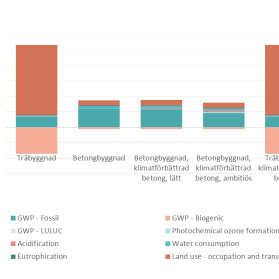The second part of Sveafastigheter's study Wood vs. concrete shows that it can be more sustainable to build multi-family buildings in concrete compared to wood when the impact on biodiversity is considered in life cycle analysis calculations. The result comes from a method development, carried out by IVL Swedish Environmental Research Institute, of the model ReCiPe, which provides a more comprehensive picture compared to commonly used climate calculation models. However, there is a need for better data and measurement methods to achieve completely reliable results.
Sveafastigheter's study Wood vs. concrete is based on two similar houses that Sveafastigheter will build, one with a wooden frame and one with a concrete frame. The purpose of the study is to make fact-based decisions about which material is most sustainable to build in from a holistic perspective, for example by adding the impact on biodiversity to life cycle analysis calculations.
– Biodiversity is one of the most vulnerable planetary boundaries. It is an environmental impact category that we in the construction and real estate industry have a large impact on but have not taken into account when calculating our climate impact. We want to broaden our calculations, which previously focused mostly on greenhouse gas emissions, says Josefine Wikström, Head of New Production, Sveafastigheter.
The study Wood vs. concrete consists of five parts. Wwood was the winner in the first part when the calculation model ReCiPe was used to add biodiversity to life cycle analyses. In the second part of the study IVL Swedish Environmental Research Institute has done a methodological development of ReCiPe, where various ambitious scenarios of frame materials have been modeled. The result show that standard wooden buildings have the highest total impact, primarily due to the impact on biodiversity as a result of land use. Concrete buildings have a lower total impact. However, it is important to highlight that the results should be interpreted as a first estimate as there is a need for improved data quality and further developed measurements to ensure full reliability.
– The results from the study are an important input to the construction and real estate industry. Even though there are uncertainties in the quantification of biodiversity in life cycle assessment and that certain aspects are not captured, it is still interesting that concrete gets a better result when more impact categories are included. This shows that a holistic perspective is important, says Emke Vrasdonk, researcher in life cycle assessment and biodiversity, IVL Swedish Environmental Institute.
By starting to use ReCiPe, the construction sector can take important steps towards more comprehensive environmental assessments, where both climate and ecosystems are taken into account. It also means that municipalities can set more initiated sustainability requirements when allocating land.
– The study shows that the common perception that wood is more sustainable than concrete can be questioned. We look forward to continuing to broaden our calculations. When the two buildings are completed, we will make life cycle calculations with biodiversity on the actual emissions, using the methods that are available at the time, says Josefine Wikström.

